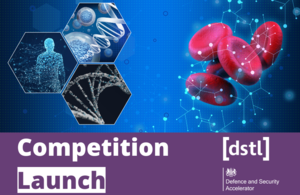Dstl is searching for generation-after-next wearable technology
Blood, sweat, tears…and saliva. Molecular measurements through biocompatible wearable technologies

- DASA has launched a new Themed Competition: Generation-after-next Wearable Technologies
- Funded by the Defence Science and Technology Laboratory (Dstl)
- Up to £750k funding available for innovative wearable technologies that focus on biocompatible materials that access information present within an individual’s bodily fluids
The Defence and Security Accelerator (DASA) is pleased to launch a new Themed Competition called Generation-after-next Wearable Technologies. Run on behalf of the Defence Science and Technology Laboratory (Dstl), this competition seeks wearable biocompatible technologies and innovations that move beyond the measurement of physical parameters such as heart rate, and instead, towards the capability to measure data present in the individual’s body fluids, such as blood, sweat, tears, saliva and tissue fluids.
For this themed competition, Dstl seeks to:
- obtain credible evidence that generation-after-next wearable technologies have the potential to protect the health and wellbeing of future Defence and Security staff
- overcome critical technical challenges to enable exploitation of novel wearable technologies
- find novel technology developments to provide relevant measures that inform critical decision making in maintaining the health and wellbeing of Defence and Security staff
Key technologies this competition will focus on include devices / assay systems, semi-implantable and fully implantable devices, studies and sensor systems, and any technology that provides robust measures of biomarkers.
Key dates and funding
Up to £750,000 is available to fund multiple proposals for generation-after-next wearable technology.
The deadline to submit a proposal is midday 25 August 2022.
Do you have an innovation? Read the full competition document and submit a proposal.
Moving beyond the smartwatch and towards biocompatible materials and sensor technologies, the ability to analyse the molecules in clinical matrices is essential to understand the health of an individual.
Currently, analyses of molecular biomarkers in clinical matrices is restricted to laboratory analysis. However, novel platforms have emerged that are capable of continuous on-person measurement of important clinical biomarkers, such as glucose.
In addition, developments in biocompatible materials, biomarker identification and measurement methods have led to a new generation of wearable sensor technologies. The development of these platforms and technologies has fostered aspirations within the defence science community to understand how they can be adapted to monitor biomarkers of interest in the defence community to improve the health and wellbeing of Defence and Security staff.
Generation-after-next wearable technologies will measure biomarkers present in the individual’s body and be able to derive immediate and long-term data on how the physical and occupational stressors impact the individual in a Defence and Security setting.
This data has the potential to provide predictive and prognostic information to prompt intervention and minimise the risk of disease and non-battle injury.
Generation-after-next wearable technology: Challenge areas
Submitted proposals should choose to target one or more of the below challenge areas.
Challenge 1
Biocompatibility, future tolerability of platforms for human use and maintenance of performance of sensor capabilities over periods of hours and potentially days depending on the target biomarker and scenario of use. For example:
- demonstration of platforms capable of reliably accessing molecular biomarkers in a range of body fluids
Challenge 2
The ability to measure several types of analyte (small molecules to larger protein targets) in a continuous assay format. This challenge area will also examine adaptability and flexibility of assays to integration of new biomarker panels as they emerge from human science research studies. For example:
- demonstration of novel continuous measurement for molecular markers (e.g. enzymes, metabolites or small molecules)
Challenge 3
Assessment of the applicability of accessible bodily fluids to measurement of particular biomolecules, i.e. studies to show presence of key biomarkers, with relevance to associated pathology, in particular sample types and indicate exploitability of these platforms in defence and security applications. For example:
- studies that demonstrate that a particular accessible fluid (e.g. sweat, saliva, tear fluid, interstitial fluid) is a relevant matrix for a particular biomarker associated with a chosen stressor of interest.
Want to learn more about these challenge areas? Read the full competition document here.
Webinars and online events
Competition Webinar: 6 July 2022
This webinar will provide more information on the challenge areas and how to submit a proposal. There will also be an opportunity to ask questions in the Q&A. If you would like to get involved, please register on the Eventbrite page
Related DASA Competition
If you’re interested in this technology area please also take a look at Engineering Biology for Defence and Security. Please note that you cannot submit the same proposal to both competitions. If you’re interested in applying but unsure which competition your innovation would be best suited to, contact your local innovation partner.
Submit a proposal
Do you have a solution or novel approach that may help our understanding of generation-after-next wearable technologies to protect the health and wellbeing of future defence staff? Submit an idea and help DASA and Dstl ensure wearable technology capabilities are informed by the latest research and developments.
Read the full competition document to learn more and submit a proposal.